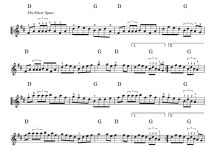skybrian
Newbie
Hi, I’m interested in learning some Scottish and Irish tunes and I’m wondering how I’d go about learning those interesting ornaments players put into them. I’m learning CBA (C griff) and it seems like it might be tricky with smaller buttons than piano keys, plus I’m playing an instrument with a compact keyboard.
I figured practicing repeated notes might help, so I spent some time on “William Tell” from Palmer & Hughes book 3, and I think I found a reasonable technique for rapidly alternating thumb and second finger on first-row buttons. Not sure where to go from there. Maybe I should use piano accordion instead?
Some songs I’ve learned the basics of (without ornaments) are “Calum’s Road” and “Off to California”.
Also, here’s a recording I like, though I don’t expect to play that well anytime soon. (Or, well, ever, really.)
“Missing Time” -
I figured practicing repeated notes might help, so I spent some time on “William Tell” from Palmer & Hughes book 3, and I think I found a reasonable technique for rapidly alternating thumb and second finger on first-row buttons. Not sure where to go from there. Maybe I should use piano accordion instead?
Some songs I’ve learned the basics of (without ornaments) are “Calum’s Road” and “Off to California”.
Also, here’s a recording I like, though I don’t expect to play that well anytime soon. (Or, well, ever, really.)
“Missing Time” -

